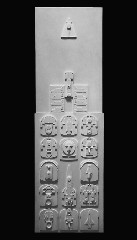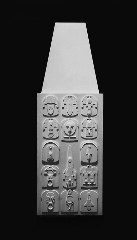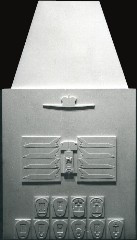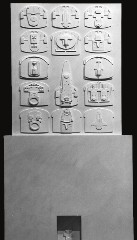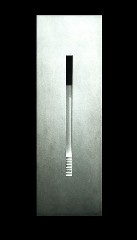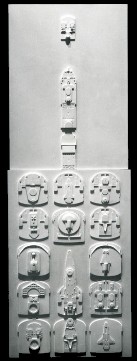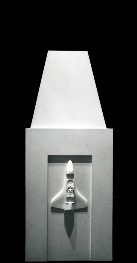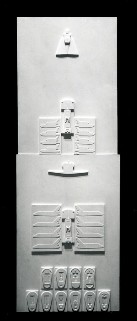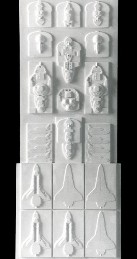Paolo Carosone
Main menu:
The NASA Obelisk
NASA OBELISK

The NASA "Obelisk for the Challenger" at the Kennedy Space Center Art Museum, Cape Canaveral and some selected details.
A Sculptor Joins NASA
Three years ago, Italy's Paolo Carosone became the first sculptor to join the little-known NASA Art Program. This program continues a long tradition in American art, the practice of bearing witness. For instance, during the last century, artists like Charles Russell and E.S. Curtis recorded the events and history that shaped the American West. The NASA artists play this role in the space program and since the Mercury flight of Gordon Cooper in 1963, American artists, famous and not-so-famous, have been recording our journey into space.
Until 1985, only painters were invited to join the program, but in that year director Bob Schulman asked the Italian sculptor Paolo Carosone to join. Not only did Carosone become the first NASA sculptor, he was the first program artist to match the high technology of the space program with the use of high technology in his own work.
Computer Sculptor Carosone, born in 1941 in Rome, is one of Italy's finest sculptors. With one-man exhibitions throughout the Continent and the United States, he has developed a reputation for sculpture that imbues classic design with a modern perspective. He is also one of the first sculptors to use the techniques of computer-aided design to create three-dimensional pieces. "I extend my manual ability with the computer. I do with the computer what I can't do with my hands;' said Carosone.
Carosone's high-tech art tool-of-choice is an Apollo DN580 graphics workstation combined with a computer-aided design software package from Selenia ItalCAD, a major Italian company and system supplier for the European Space Consortium.
"I go from concept to fully formed three-dimensional figures right on the screen:'
Carosone uses the CAD system to create three-dimensional "models" that are far more mathematically accurate than any he could build by hand. When he's satisfied that the models capture his aesthetic meaning, Carosone prints the different layers of the model separately so that he winds up with a series of patterns that together combine into the three-dimensional computer model.
These patterns are turned into photo etchings at a laboratory in Milan that uses the same methods that are used for printed circuits. "By using the advanced techniques taken from electronic circuitry design I get etchings with very crisp edges and very,very high definition, both of which are important to my sculpture, says Carosone.
The photo etchings are used, in turn, to cut metal sheets of each layer of the design. As a result of the exacting accuracy of Carosone's design methods, the different layers fit together perfectly. In fact, peg holes are incorporated in the original computer design so the different layers come together just like children's construction blocks.
Another advantage of computer-aided design methods is that Carosone can easily draw complex and detailed patterns on the sculpture that come out so perfect that it takes a powerful lens to detect flaws.
One of the designs that had influenced program director Schulman to invite Carosone to join the NASA Art Project was for a starkly impressive and stately obelisk. In the aftermath of the Challenger tragedy the building of the obelisk as a memorial to the fallen astronauts became an obsession of both Carosone and Schulman. Though he didn't witness the accident and, in fact, had been unexpectedly called away the day before the launch, Carosone says "all my emotional drive was put into this piece and it became my total dedication for two years.
Carosone used his high-tech methods to craft a structure that he thought would do justice to the astronauts' memory. Made of epoxy and pure white, the final result of Carosone's passion stands a stately 75 feet. It's divided into 7 sections, each one representing a Challenger astronaut. "The white catches the light and, of course, it also catches the shadows giving the obelisk a very peaceful, very magical appearance; 'says Carosone.
Carosone's obelisk was dedicated at a ceremony in honour of the lost astronauts at Cape Kennedy on August 1, 1987. The Free World Symphony Orchestra played and astronauts Alan Bean and Orlon Kripton spoke of their fallen comrades. The space program's NASA Art Gallery at the Cape was also opened on the same day.
Carosone's obelisk is now on permanent exhibition at the gallery.
NASA astronauts and employees and visitors were all impressed with the sculpture, but Carosone now dreams of building a sculpture twice as big and made of stainless steel to commemorate the Challenger crew.
From:
The Newsletter of Apollo Computer Inc.
"NASA Artist Paolo Carosone"
By Nadine Wallack

-----------Details of the Obelisk segments
Click to enlarge
Click to enlarge


